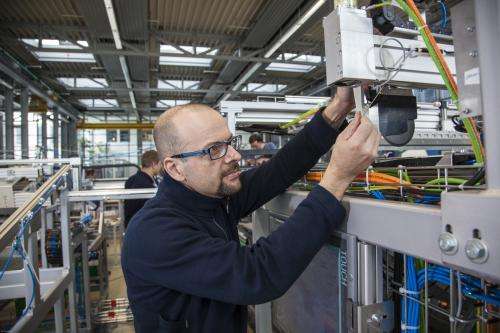Planning and building products and production plants simultaneously

Fraunhofer researchers have developed and built new production plants in record time for the specialty chemicals company LANXESS and many other companies. Methods of digital engineering allow research and development for the planning of products and manufacturing to proceed simultaneously. Visitors to the Hannover Messe from April 7 to 11 can learn how this works.
In early 2010, LANXESS decided to enter a new field of business, water purification: A production facility for Lewabrane reverse osmosis membrane filter elements was supposed to be built by the fall of 2011. Together with the company's experts, researchers from the Fraunhofer Institute for Factory Operation and Automation IFF in Magdeburg designed and had the manufacturing technology ready for production in just nine months. Afterward, they built a second, fully automatic and, therefore, more complex plant in just one year. Part of this plant – scaled down – will be on display for the first time at our booth at Hannover Messe.
Simultaneous Development and Functional Testing
Small and medium-sized companies that manufacture one off and small series especially profit from the advantages of digital engineering, namely far shorter development times, lower costs and more highly developed designs. Researchers from the Fraunhofer IFF have made it their mission to enable machinery manufacturers to use these methods in their companies.
"We reorganized what has been the usual workflow when developing and implementing custom machinery, for instance," explains Prof. Ulrich Schmucker, manager of the Virtual Engineering Business Unit at the Fraunhofer IFF. "Previously, the design engineers would start, and then the electrical engineers would join in, followed by the programmers and finally the commissioning engineers. With our new methods, everyone works together from the start. The programmers can already start developing software before the machine exists. This step usually doesn't come until the end, once the equipment has been built and connected." This is possible since both the product and every single step of the process are simulated on a computer. The researchers link all of the digital data available.
Cost Effective Custom Development
"We develop custom solutions for whatever clients need," stresses Schmucker. The Fraunhofer IFF's development methods are especially useful for the manufacture of custom maschines and small quantities. Small and medium-sized companies like SM Calvörde, which manufactures rolling stock among other things, Schiess AG, which manufactures machine tools, AEM – Anhaltische Elektromotorenwerk Dessau GmbH, which manufactures large generators, and many others have already successfully implemented systems with Fraunhofer. This research has been funded by the state of Saxony-Anhalt, internal resources and industry projects.
Schmucker uses the trade fair exhibit to explain the system: "The machine moves virtually here on the monitor on the wall just like the real machine behind this model. The special thing is: The virtual system, not a film, is running here on the screen. It is operated by the original controller, that is, a controller exactly like the one in LANXESS's membrane technology production facility in Bitterfeld."
Maintenance, Repair and Training
"We use the development data not only for planning and construction but also for maintenance, repair and training," says Schmucker, describing more of the system's advantages. "One example: A machine stops; one sensor has slipped out of place. But which of the 800 sensors isn't functioning? The technician immediately sees the location of the malfunction on his or her tablet and can order a replacement part directly. This is possible because all of the machine is available digitally."
Operator training can also start before a system exists – specifically, on the real controller as well. Future users are trained in its operation on virtual equipment at the institute or at their company. The operator interface is identical with that of the future machine. Instead of the machine, only the virtual copy on the screen moves.
Provided by Fraunhofer-Gesellschaft





















